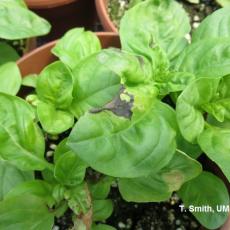Pseudomonas cichorii causes a bacterial leaf spot on basil. The bacterium has a wide host range, but is not known to exhibit host specificity. P. cichorii is most important in chrysanthemum, geranium, and many other ornamental and foliage plants. Like Pseudomonas syringae, P. cichorii can be present on asymptomatic plants (epiphytic populations) allowing long distance distribution of the bacterium via propagative material. Local spread within a crop is by rain or irrigation. Seed, infected cuttings, and infected plantlets are the most likely sources of infection. Disease development is highly favored by high relative humidity, extended periods of leaf wetness, and high nitrogen levels. Sanitation is the most important disease management principle. Remove and destroy affected plants and infected plant debris. Bacteria are easily spread by water splash and handling infected tissue. Minimize splashing and reduce leaf wetness duration by watering early in the day or subirrigating. Reduce relative humidity by improving air circulation with fans, plant spacing, and by heating and venting. Do not handle plants when foliage is wet. Copper products are registered for control, but bactericides are only marginally effective in controlling bacterial diseases. There are several copper products labeled for greenhouse vegetable transplants, but only a few are labeled for herbs. Check labels for host appropriateness. Sanitation and environmental control are extremely important disease management principles.

